The Scombriformes order of the Percomorpha clade, like many others, became “independent” not so long ago. It was considered the Scombroidei suborder of the Perciformes order until recently. The order comprises two fish suborders – Scombroidei and Stromateoidei.
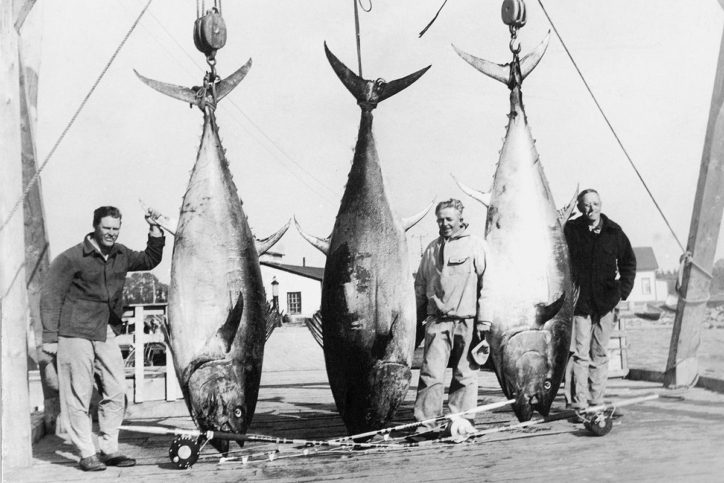
(Anglers with bluefin tunas. Photo © web.colby.edu)
The Scombroidei suborder is represented by three families, including cutlassfishes (Trichiuridae), snake mackerels (Gempylidae), and mackerels, tunas, bonitos (Scombridae). Fishes of these families inhabit the Adriatic Sea.
The cutlassfishes (Trichiuridae) family comprises 45 fish species of 15 genera. They inhabit the temperate, subtropical and tropical waters of the Pacific, Atlantic, and the Indian Ocean. The razorback scabbardfish (Assurger anzac) is the largest representative of the family. It inhabits the Pacific Ocean and maybe up to 2.5 meters long. The silver scabbardfish (Lepidopus caudatus), weighing up to 8 kilograms, is the “heaviest” one.
And the largehead hairtail (Trichiurus lepturus), commercially important fish, which is in the top ten as regards the amount of fish being caught annually, is the most well-known one. Most fish are caught in China, Taiwan, South Korea, Japan, and Pakistan. Moreover, largehead hairtail is a popular sport fishing target, especially in Japan and South Korea. In the recent decade, vertical jigging has become one of the most popular ways to catch it. Almost every serious fishing gear producer from Oriental countries sells jigs specially designed for catching cutlassfishes.
The cutlassfishes have a long, usually, silver or iron-grey, heavily compressed laterally body. They have a very long dorsal fin and a small caudal fin. Some species don’t have a caudal fin at all. They also have a small head with an underhung lower jaw and large teeth resembling fangs. Most fishes of the family are predators. Cutlassfishes freeze upright in the water while chasing prey. Observing their behavior is truly mesmerizing.
Cutlassfish Vertically Feeding ~ #CostaRicaDeep expedition ROV livestream
Beautiful school of Cutlassfish, vertically feeding in the water column. Lit up by the lights on ROV SuBastian while exploring on the #CostaRicaDeep expedition. More information about the research: https://schmidtocean.org/cruise/costa-rican-deep-sea-connections/
Опубликовано Schmidt Ocean Institute Среда, 9 января 2019 г.
(Cutlassfishes chasing prey. Video © Schmidt Ocean Institute. facebook.com/SchmidtOcean)
Some species of cutlassfishes are found at depths of about 2000 meters.
Two representatives of the family are found in the Adriatic Sea:
Silver scabbardfish (Lepidopus caudatus).
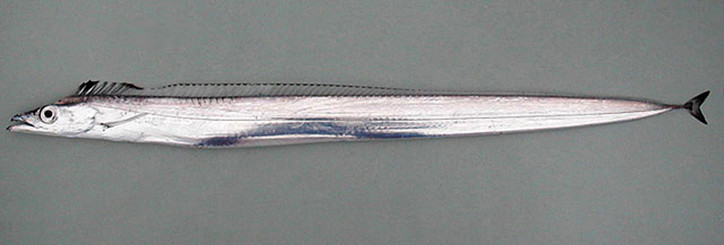
(Silver scabbardfish. Photo by © Pedro Niny Duarte(c)ImagDOP. fishbase.org)
It is a bottom pelagic schooling species. It inhabits the depth of 40-620 meters, usually 100-300 meters. It dwells near a sandy and silty bottom. The maximum recorded length is 210 cm, specimens up to 120 cm long are more common. The maximum weight is 8 kilograms. At night, it can migrate closer to the surface, sometimes fish approaches the shores of the sea. It feeds on crustaceans, squids, and fish. It is a permanent rare inhabitant of the Adriatic Sea.
Largehead hairtail (Trichiurus lepturus).

(Largehead hairtail. Photo © armacao.exblog.jp)
It is a pelagic schooling species. It inhabits the depths of up to 590 meters, usually 100-350 meters. It dwells near a sandy and silty bottom. The maximum recorded length is 234 cm, specimens up to 100 cm long are more common. The maximum weight is 5 kilograms. It feeds on crustaceans, squids, and fish. Adult fish rise closer to the surface and feed during the day, young fish, on the contrary, at night. It is a permanent rare inhabitant of the Adriatic Sea. It is more common in the central and southern parts of the Adriatic.
The snake mackerels (Gempylidae) family comprises 24 abyssal fish species of 16 genera. Inhabitants of tropical and subtropical waters look like barracudas with an elongated body, sharp teeth resembling fangs. Until recently, they were considered closely related to fishes. But scientific studies show that they are more distant relatives than it seemed at a first scientific glance.
Most fishes of the family are not more than 70 centimeters long, but some fish may be of considerable dimensions. The oilfish (Ruvettus pretiosus) is the largest fish. It may be up to 3 meters long and weigh 63.5 kilograms. Some species are commercially important locally.
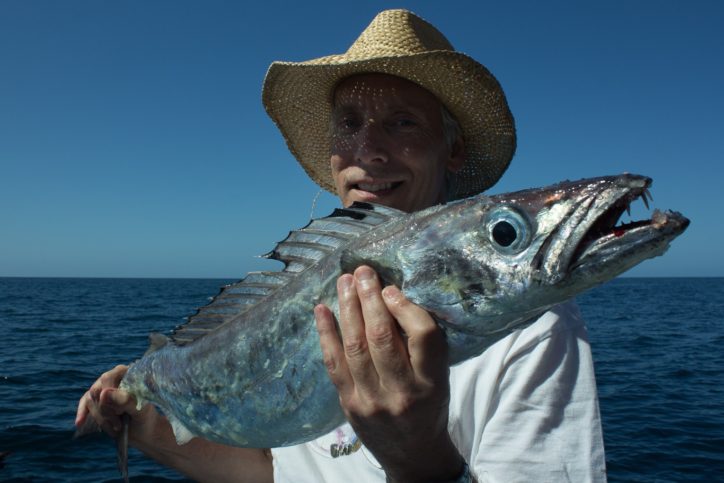
(Silver gemfish. Photo by © Andym5855. wikipedia.org)
For example, the silver gemfish (Rexea solandri), which may weigh 16 kilograms, is one of the most important commercial species in the coastal waters of southeast Australia, New Zealand, and Tasmania. And the snoek or barracouta (Thyrsites atun), which may be 2 meters long and weigh 6 kilograms, is widespread in the cold waters of the Southern Hemisphere. It is a popular fish in the cuisine of South Africa. Some fishes of the family are sport fishing targets.
One representative of snake mackerels is found in the Adriatic Sea:
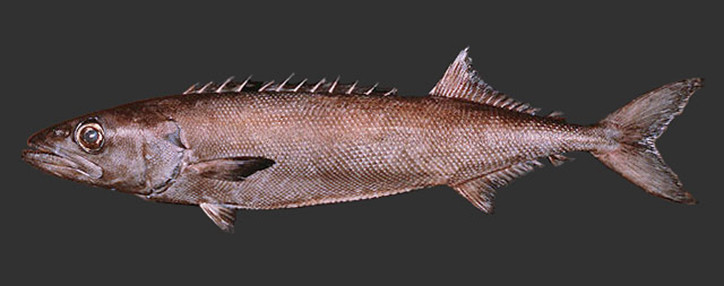
(Oilfish. Photo by © John E. Randall. fishbase.org)
It inhabits the depth of 100-800 meters, usually 200-400 meters. It lives near the bottom, far from the coast, alone or in pairs. The maximum recorded length is 300 cm, specimens up to 150 cm long are more common. The maximum weight is 63,5 kilograms. It feeds on fish, crustaceans, and squid. It is a permanent inhabitant of the Adriatic Sea. It is more common in the central and southern parts of the Adriatic. The flesh is very fatty. When consumed in large quantities, it can cause indigestion, and even poisoning. In small quantities, it is considered a delicacy.
The Scombridae family comprises 15 genera and 54 fish species, many of which are the most important commercial and sport fishing targets. The family comprises two subfamilies – Gasterochisma and Scombrinae, the latter includes 4 tribes: true mackerels (Scombrini), Spanish mackerels (Scomberomorini), bonitos (Sardini), and tunas (Thunnini).
Gasterochisma is represented by only one fish species – the butterfly kingfish (Gasterochisma melampus). The butterfly kingfish is a predator that inhabits the temperate waters of all the oceans of the Southern Hemisphere. It may be more than 160 centimeters long and weigh more than 40 kilograms. It is a sport fishing target. It differs from other representatives of the family by large scales and the absence of a strong central keel on the tail stalk.
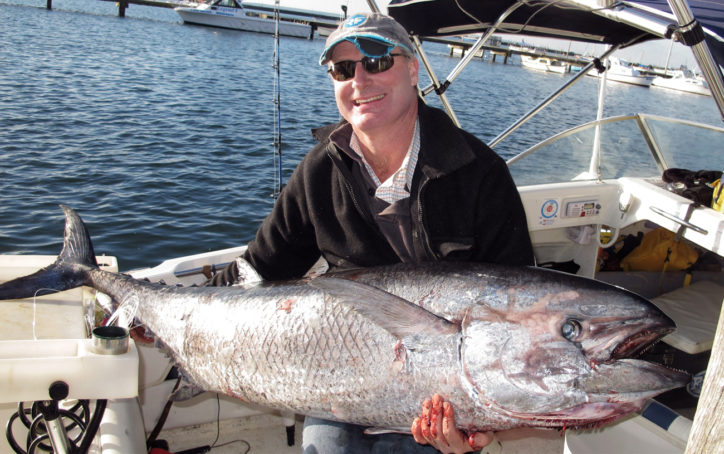
(Butterfly kingfish. Photo by © Jo Steff / Matthew Hunt Fishing Services Pty Ltd. fishesofaustralia.net.au)
The Scomberomorini tribe, often referred to as Spanish mackerels, of the Scombrinae subfamily comprises 3 genera.
The first genus is Acanthocybium with its only species, wahoo (Acanthocybium solandri). Due to a thin elongated body, it is one of the fastest ocean fishes that can move in the water at a speed of up to 97 km/h. This solitary predator may be up to 2.5 meters long and weigh 83 kilograms. On average, it is about one and a half meters long. It inhabits the tropical and subtropical waters of the Atlantic, Indian, and the Pacific Ocean, including the Mediterranean Sea. It is one of the most popular sport fishing targets. However, wahoo likes warm water, so it hasn’t got to the relatively cool Adriatic.

(Wahoo. Photo © delphfishing.com)
The second genus is Grammatorcynus. It comprises two fish species that inhabit the Indo-Pacific region. They have an elongated, slightly compressed laterally, body. They are both commercial and sport fishing targets. The larger shark mackerel (Grammatorcynus bicarinatus) may be up to 112 centimeters long and weigh 13.5 kilograms, the smaller double-lined mackerel (Grammatorcynus bilineatus) may be up to a meter long and weigh 3.5 kilograms.

(Shark mackerel. Photo © alchetron.com)
The third genus is Scomberomorus. It comprises 18 fish species. All of them are predators. They are both an important commercial and sport fishing target. In turn, large tunas, marlins, sharks, and dolphins prey on Scomberomorus. The Chinese mackerel (Scomberomorus sinensis), also known as the Chinese seerfish, is the largest fish of the genus. It may be up to 2.5 meters long and weigh up to 130 kilograms.

(Narrow-barred Spanish mackerel (Scomberomorus commerson). Photo © halcotackle.com)
Like fishes of the Acanthocybium genus, fishes of the Grammatorcynus genus are not found in the Adriatic Sea, but adriaticnature couldn’t help but mention them in this article. However, the representatives of the other three tribes are represented in the Adriatic.
The true mackerels (Scombrini) tribe comprises two genera: the Rastrelliger genus with three species, and the Scomber genus with five fish species.
Rastrelliger is inhabitants of the Indo-Pacific region, an important local commercial fishing target. The short mackerel or shortbodied mackerel (Rastrelliger brachysoma), which may be up to 34.5 centimeters long, is important in Thai cuisine. The Thai people often call it “fish of the nation” due to its prevalence and availability. The Indian mackerel (Rastrelliger kanagurta), which may be up to 35 centimeters long, is an important product in the cuisine of the countries of South and Southeast Asia. It has recently penetrated into the Mediterranean Sea through the Suez Canal, although it hasn’t been found in the Adriatic yet.
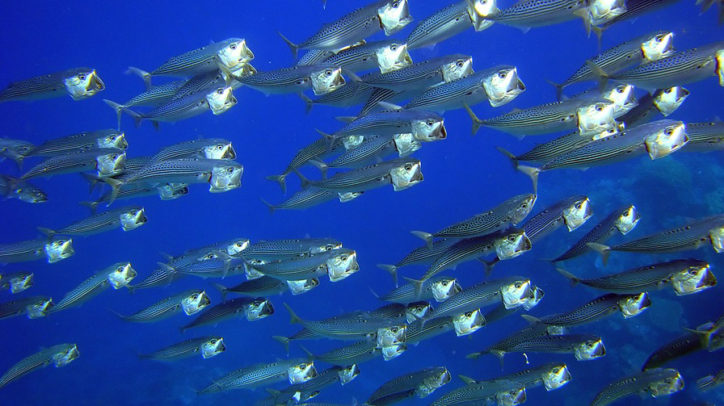
(Indian mackerel. Photo by © Dino van doorn. wikipedia.org)
Fishes of the Scomber and Rastrelliger genera are both an important commercial fishing target and a significant food link for many predators, including tunas, swordfishes, and others. Mackerels are schooling plankton filterers, filtering off small crustaceans from the water. Adult specimens prey on small fish and squid. There are two representatives of the genus Scomber in the Adriatic Sea:
Atlantic chub mackerel (Scomber colias).
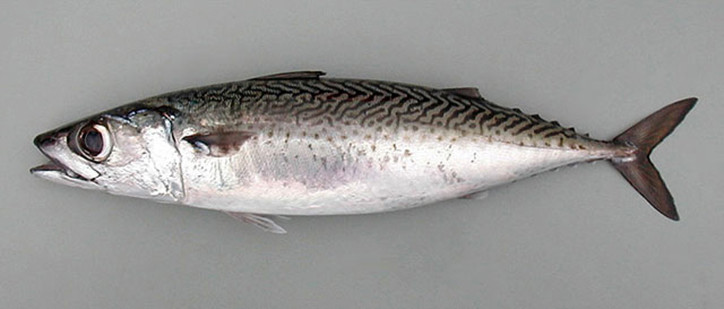
(Atlantic chub mackerel. Photo by © Pedro Niny Duarte(c)ImagDOP. fishbase.org)
It is a pelagic schooling species. It inhabits the depths of up to 300 meters, usually 50-200 meters. The maximum recorded length is 64 cm, specimens up to 30 cm long are more common. The maximum weight is 2,9 kilograms. It feeds on fish, crustaceans, and squid. Adult fish in the daytime are near the bottom, at night they rise closer to the surface. It is a permanent inhabitant of the Adriatic Sea.
Atlantic mackerel (Scomber scombrus).
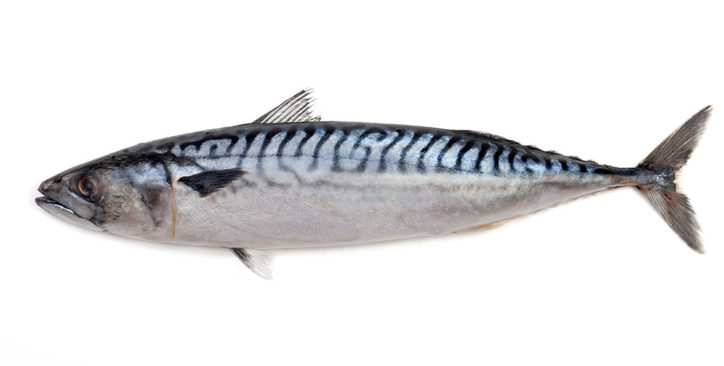
(Atlantic mackerel. Photo © northlakefisheries.ca)
It is a pelagic schooling species. It inhabits the depths of up to 1000 meters, usually up to 200 meters. The maximum recorded length is 60 cm, specimens up to 30 cm long are more common. The maximum weight is 3,4 kilograms. It feeds on small fish and zooplankton. It is a permanent inhabitant of the Adriatic Sea.
The bonitos (Sardini) tribe comprises 4 fish genera, each of which is important in sport fishing.
Fishes of the Sarda genus are schooling predators, which inhabit the tropical and subtropical waters of all the oceans. Schools are formed according to the size of specimens. They feed on small fish, shrimp and squid. They have a fairly large mouth with sharp conical teeth. The genus comprises the following five species: Australian bonito (Sarda australis), which inhabits the subtropical waters of the eastern Indian and southwestern Pacific Ocean, it may be up to a meter long and weigh 9.4 kilograms; eastern Pacific bonito (Sarda chiliensis), which may be up to 102 centimeters long and weigh 11.3 kilograms; Pacific bonito (Sarda lineolata), which was considered the same species as Sarda chiliensis until recently; striped bonito (Sarda orientalis), which inhabits the subtropical and tropical waters of the Indian and Pacific Ocean, it may be up to 102 centimeters long and weigh 10.7 kilograms; and Atlantic bonito (Sarda sarda), which is one of the most popular sport fishing targets in the Adriatic Sea:
Atlantic bonito (Sarda sarda).

(Atlantic bonito. Photo © biogeodb.stri.si.edu)
It is a pelagic schooling species. It often enters deep bays. It inhabits the depths of up to 200 meters. The maximum recorded length is 91,4 cm, specimens up to 50 cm long are more common. The maximum weight is 11 kilograms. It feeds on fish, invertebrates, squid, and shrimp. It is a permanent inhabitant of the Adriatic Sea.
The only representative of the Cybiosard genus, the leaping bonito (Cybiosarda elegans), is a schooling predator of the coastal and ocean waters of northern Australia and southern New Guinea. It may be up to 45 centimeters long and weigh 2 kilograms. Local anglers often use this fish as baitfish for catching large tunas and sharks.

(leaping bonito. Photo by © conchydong. thehulltruth.com)
The only representative of the Gymnosarda genus is the dogtooth tuna (Gymnosarda unicolor). This fish is the “queen” of the bonitos tribe. It may be up to 2.5 meters long and weigh up to 130 kilograms. Dogtooth tuna can move in the water at a speed of up to 80 km/h. It is widely spread in the Indo-Pacific region from the Red Sea and the east coast of Africa to French Polynesia. This fish can be found in the north up to the coast of Japan, and in the south up to the coast of Australia. It is one of the most valuable sport fishing targets. When this fish is caught, it struggles fiercely. But finding large specimens is not so easy. Dogtooth tuna prefers to swim close to coral reefs at depths of up to 300 meters. Basically, it’s a solitary predator. But sometimes these fish form small schools in order to prey. In addition to the fact that large specimens are quite rare, they are even less common in areas where active fishing is carried out. In recent years, vertical jigging has been one of the most popular ways to catch dogtooth tuna.
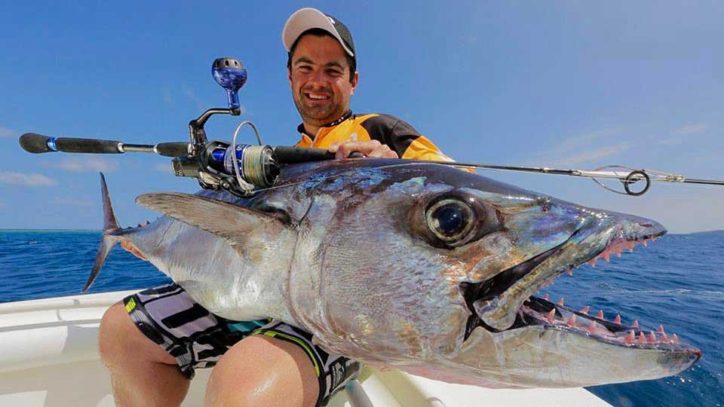
(Dogtooth tuna. Photo © Ocean Blue. oceanbluefishing.com)
The last, fourth, genus of the Sardini tribe is Orcynopsis. It is represented by a single species, the plain bonito. (Orcynopsis unicolor), as well. This schooling predator inhabits the north-eastern part of the Atlantic Ocean. It is found in the Mediterranean Sea. Nevertheless, it prefers to swim close to its southern shores, where it is a commercial species. It is caught in such countries as Mauritania, Morocco, and Portugal in small amounts. Occasionally, it can be found in the Adriatic:
Plain bonito (Orcynopsis unicolor).
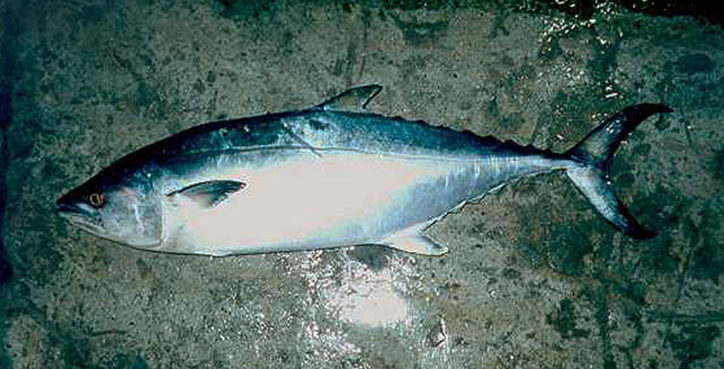
(Plain bonito. Photo by © Trevor Meyer. fishbase.org)
It is a pelagic schooling species. The maximum recorded length is 130 cm, specimens up to 90 cm long are more common. The maximum weight is 13,1 kilograms. It feeds on small fish. It is a rare inhabitant of the Adriatic Sea.
The tunas (Thunnini) tribe comprises 15 fish species belonging to 5 genera. Almost everyone knows these fishes – all of them are called “tuna”. Their sizes vary greatly – from 50 centimeters and 1.8 kilograms (bullet tuna) to 4.6 meters and 684 kilograms (Atlantic bluefin tuna).
Tunas are among the fastest swimming pelagic fishes. Yellowfin tuna can swim at a speed of up to 75 km/h. Tunas, opahs, and sharks of the Lamniformes order are the only fish that can maintain a body temperature higher than the temperature of the surrounding water. They have a well-developed blood supply and hemoglobin-rich blood. They inhabit the tropical and subtropical waters of the Atlantic, Pacific, and the Indian Ocean.
Tunas are an important commercial fishing target. For example, the amount of skipjack tuna (Katsuwonus pelamis) being caught around the world is second only to the amount of Peruvian anchoveta (Engraulis ringens), which is considered to the largest fish on the planet, and Alaska pollock or walleye pollock (Gadus chalcogrammus) being caught.
Tunas are mighty fighters, that’s why they of the most desired trophies for sport anglers. This is no exception for the Adriatic Sea.
The Allothunnus genus is represented by a single species – slender tuna (Allothunnus fallai). It inhabits the subtropical and tropical waters of the Indian, Atlantic and Pacific Ocean in the Southern Hemisphere. Therefore, it doesn’t get to the Adriatic. It may be a little more than a meter long and weigh 13.7 kilograms.
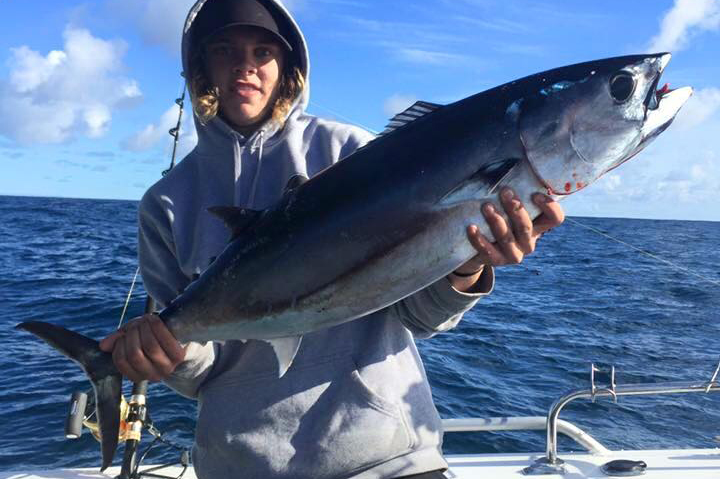
(Slender tuna. Photo by © Dermott Yawney. fishesofaustralia.net.au)
The Auxis genus comprises four fish species. They inhabit the coastal tropical and subtropical waters of all the oceans. They feed on plankton, cephalopods and small fish. They are of great commercial importance. The genus consists of small fishes, the most numerous of which, frigate tuna (Auxis thazard), maybe up to 65 centimeters long and weigh 1.7 kilograms. They often form schools along with other mackerels. One species of the genus is found in the Adriatic Sea:

(Bullet tuna. Photo © armacao.exblog.jp)
It is a pelagic schooling species. It inhabits the depths of up to 50 meters. The maximum recorded length is 50 cm. The maximum weight is less than 2 kg. It feeds on small fish, crustaceans and squid. It is a permanent inhabitant of the Adriatic Sea.
The Euthynnus genus comprises 3 fish species, which inhabit the coastal tropical and subtropical waters of all the oceans. They are schooling fish, which feed on small fish, crustaceans, and squid. In turn, large tunas, marlins, and sharks prey on them. The species look quite alike. Black skipjack or black skipjack tuna (Euthynnus lineatus) is common in the tropical waters of the Pacific Ocean, kawakawa or mackerel tuna (Euthynnus affinis) inhabits the coastal tropical and subtropical coastal waters of the Indian and Western Pacific Ocean, and the largest representative of the genus, little tunny (Euthynnus alletteratus), is one of the most frequent trophies in the catches of shore jigging and trolling fans in the Adriatic.
Little tunny or false albacore (Euthynnus alletteratus).
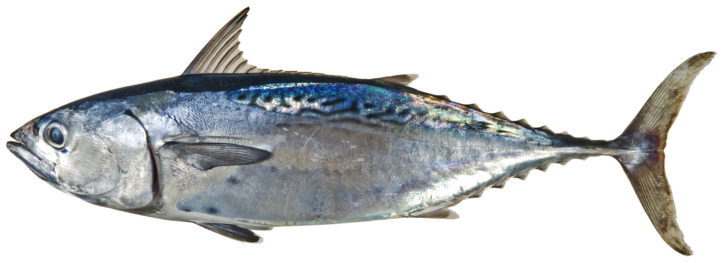
(Little tunny. Photo by © JT Williams. commons.wikimedia.org)
The skipjack tuna (Katsuwonus pelamis) is the only representative of the Katsuwonus genus. A schooling pelagic predator is found in all the oceans except for the Arctic Ocean. The body of this tuna is thicker and rounder than that of its relatives, with dark longitudinal stripes on the sides and belly. It is the most fecund commercial tuna, a popular sport fishing target. The skipjack tuna is occasionally found in the Adriatic Sea:
Skipjack tuna (Katsuwonus pelamis).
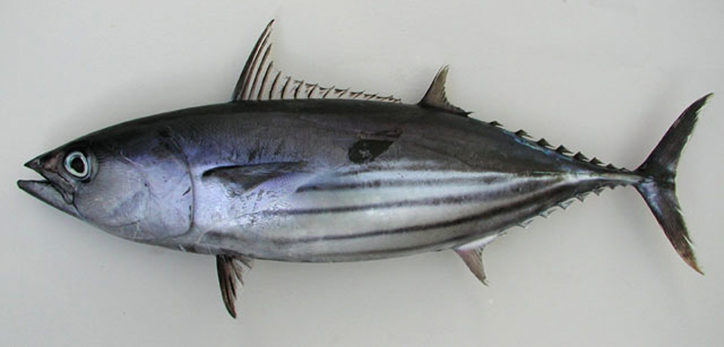
(Skipjack tuna. Photo by © Shunji Fujiwara, Rui Patricio Freitas. fishbase.org)
It is a pelagic schooling species. It inhabits the depths of up to 260 meters. The maximum recorded length is 110 cm, specimens up to 80 cm long are more common. The maximum weight is 34,5 kilograms. It feeds on fish, crustaceans, and squid. It is a rare inhabitant of the Adriatic Sea, more commonly found in its southern part.
The Thunnus genus, sometimes referred to as “real tuna”, comprises 8 fish species belonging to two subgenera: Thunnus (Thunnus), “bluefin”, and Thunnus (Neothunnus), “yellowfin”. Recent DNA analyzes have shown that such a classification is not very accurate but we won’t go into details.
Three fish species are currently referred to as “yellowfins”: yellowfin tuna (Thunnus albacares), which inhabit all the tropical and temperate waters of the world’s oceans, but avoid the waters of the Mediterranean Sea for some reason, they may be up to 2 meters long and weigh 200 kilograms; blackfin tuna (Thunnus atlanticus), which inhabit the western Atlantic from Cape Cod to Brazil, they may be up to a meter long and weigh 21 kilograms; and longtail tuna (Thunnus tonggol), which are found in the tropical and subtropical waters of the Indian and the Pacific Ocean, they may be almost a half meter long and weigh 36 kilograms.
The yellowfin tuna (Thunnus albacares) is one of the most popular sea sportfishing targets in the world. However, unfortunately, as we mentioned before, it doesn’t get into the Mediterranean Sea, and therefore into its coldest part, the Adriatic Sea, just like other “yellowfins”.

(Yellowfin tuna. Photo © blackmagictackle.com)
Five fish species are referred to as “bluefins”. Three of them are not found in the Adriatic Sea. They are: southern bluefin tuna (Thunnus maccoyii), which inhabit the temperate waters of all the oceans of the Southern Hemisphere, they may be up to 2.5 meters long and weigh 260 kilograms; bigeye tuna (Thunnus obesus), which inhabit the tropical and subtropical waters of the Atlantic, Pacific and the Indian Ocean, they may be up to 2.5 meters long and weigh 210 kilograms; and Pacific bluefin tuna (Thunnus orientalis), which inhabit mainly the northern part of the Pacific Ocean, they may be up to 3 meters long and weigh 450 kilograms. But, while there is a slim chance of seeing albacore or longfin tuna (Thunnus alalunga), although it has been caught more often recently, the largest representative of the entire order, Atlantic bluefin tuna (Thunnus thynnus), is a permanent inhabitant of the Adriatic and a sport fishing target.
Albacore or longfin tuna (Thunnus alalunga).
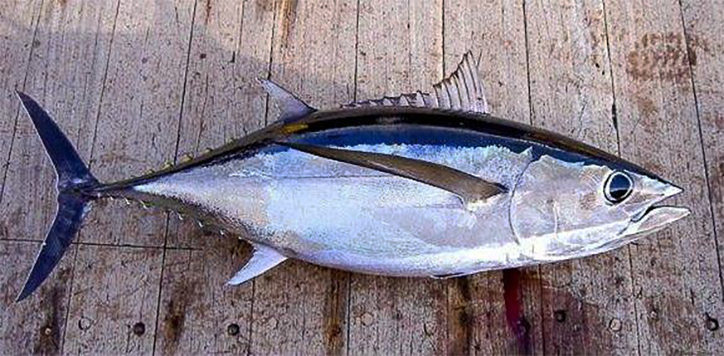
(Albacore. Photo © The Online Guide to the Animals of Trinidad and Tobago. findeatdrink.com)
It is a pelagic schooling species. It inhabits the depths of up to 600 meters. The maximum recorded length is 140 cm, specimens up to 100 cm long are more common. The maximum weight is 60,3 kilograms. It feeds on fish, crustaceans, and squid. It is a rare inhabitant of the Adriatic Sea, more commonly found in its southern part. It is put on the IUCN Red List as a near threatened (NT) species.
Atlantic bluefin tuna (Thunnus thynnus).

(Atlantic bluefin tuna. Photo © Muséum national d’Histoire naturelle (S. Iglesias). fishbase.org)
It is a pelagic schooling species. It inhabits the depths of up to 985 meters, usually up to 100 meters. The maximum recorded length is 458 cm, specimens up to 200 cm long are more common. The maximum weight is 684 kilograms. It feeds on fish, crustaceans, and squid. It is a permanent inhabitant of the Adriatic Sea. It is listed in IUCN Red List as an endangered species (EN).
The Stromateoidei suborder of the Scombriformes order comprises about 73 fish species of 16 genera and 6 families. Many of them are deep-water inhabitants and are in symbiosis with jellyfish. Some fishes of the suborder use them as protection and others – as food. They inhabit almost all the tropical and temperate sea waters. Representatives of three families are found in the Adriatic Sea.
The medusafishes (Centrolophidae) family comprises 31 fish species. Three of them are found in the Adriatic:
Black ruff (Centrolophus niger).

(Black ruff. Photo © Ichthyology Database of the Swedish Museum of Natural History. artedi.nrm.se)
It is a pelagic species, can be grouped into small schools. It inhabits the depth of 40-1050 meters, usually 300-700 meters. The maximum recorded length is 150 cm, specimens up to 60 cm long are more common. It feeds on small fish, squid, crustaceans, and zooplankton. It is a permanent infrequent inhabitant of the Adriatic Sea.
Cornish blackfish (Schedophilus medusophagus).
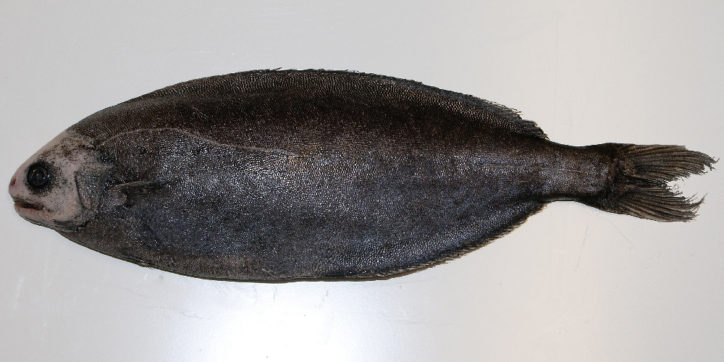
(Cornish blackfish. Photo © Ichthyology Database of the Swedish Museum of Natural History. artedi.nrm.se)
It is a pelagic species. It inhabits the depth of 200-360 meters. The maximum recorded length is 51 cm. It feeds on jellyfish and ctenophores. It has been found in the Adriatic Sea several times.
Imperial blackfish (Schedophilus ovalis).

(Imperial blackfish. Photo by © Pedro Niny Duarte(c)ImagDOP. fishbase.org)
It inhabits the depth of 70-700 meters, usually 80-240 meters. The maximum recorded length is 100 cm, specimens up to 60 cm long are more common. It feeds on fish, squid, jellyfish. It has been found in the Adriatic Sea several times.
The driftfishes (Nomeidae) family comprises 16 fish species. One of them is found in the Adriatic:
Driftfish (Cubiceps gracilis).
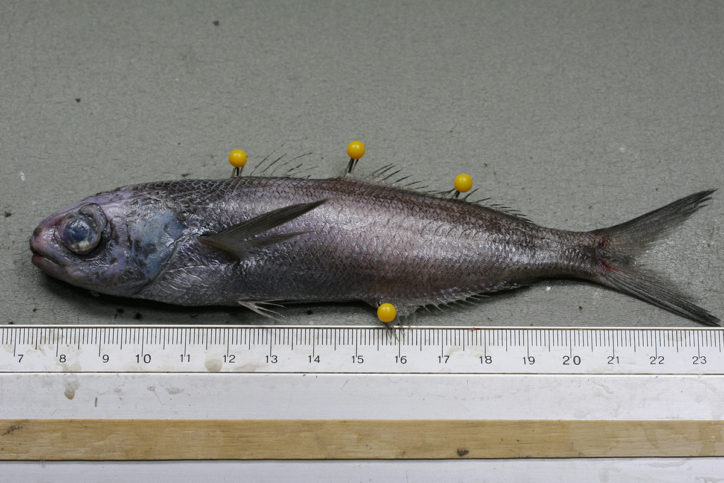
(Driftfish. Photo © IMARES. iucnredlist.org)
It is a pelagic species. It inhabits the depths of up to 300 meters. The maximum recorded length is 100 cm. It feeds on salps. It is a rare species. It is an inhabitant of the Adriatic Sea.
The butterfishes (Stromateidae) family comprises 17 fish species. Two of them are found in the Adriatic:
Silver pomfret (Pampus argenteus).
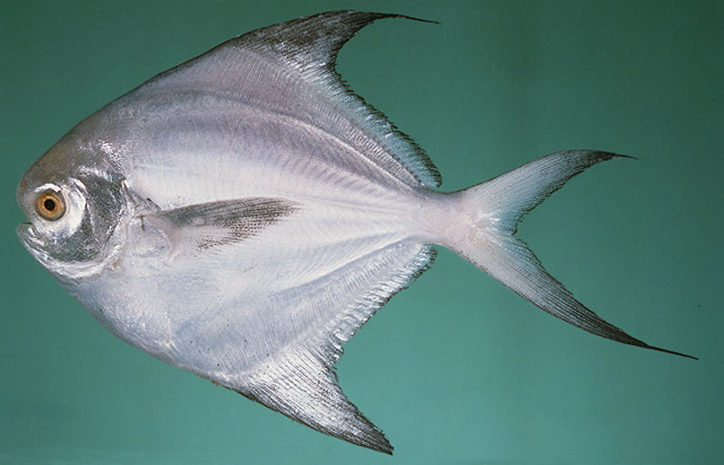
(Silver pomfret. Photo by © John E. Randall. fishbase.org)
It is a pelagic schooling species. It inhabits the depth of 15-110 meters. It dwells near a silty bottom. The maximum recorded length is 60 cm, specimens up to 30 cm long are more common. It feeds on ctenophores, salps, jellyfish, and other zooplankton. It is an inhabitant of the western Pacific region. Isolated encounters with this fish have been recorded in the northeast part of the Adriatic Sea. Probably penetrated from the Pacific Ocean along with the ballast waters of the ships, or migrated following the jellyfish.
Blue butterfish (Stromateus fiatola).

(Blue butterfish. Photo © armacao.exblog.jp)
It is a pelagic schooling species. It inhabits the depth of 10-70 meters. The maximum recorded length is 50 cm, specimens up to 40 cm long are more common. It feeds on small fish, jellyfish, and zooplankton. It is a rare inhabitant of the Adriatic Sea, more common in its southern part.